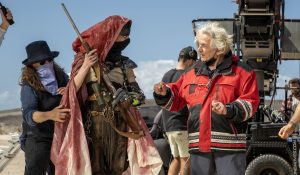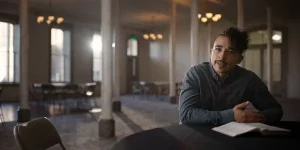
Forget murders, Netflix‘s latest hot doc is about schools. Only they’re not really schools, they are prisons, they make millions of dollars and destroy thousands of lives, and the bigwigs at the top of these horrific establishments keep getting away with it…
This is The Program: Cons, Cults and Kidnapping which focuses on troubled teen programs set up at facilities claiming to offer help to young people through therapy and activities. In reality teens were often forcibly removed from their homes, not allowed to speak, look out of the window, smile at their classmates, and in fact had to get permission to even fart. They were ill fed, tortured, brainwashed and kept away from their families, often for years. And the families paid thousands of dollars for the service.
The Program is a wonderful documentary, in no small part because the filmmaker Katherine Kublar was a victim of one of these establishments herself. Kublar reunites with other survivors to investigate and expose what happened to them. We talk about the importance of putting the victims at the front and center of true crime documentaries – these survivors are telling their own stories in their own way and striving to make those responsible accountable. It’s all the more powerful for that, and less a victim story than a method of healing and even revenge.
Kublar attended the Academy at Ivy Ridge for 15 months from age 16. Her father and stepmother signed her up after she was excluded from a private Christian boarding school for drinking hard lemonade. But rather than coming home, Kathering was taken by representatives of the academy to Ivy Ridge where she was told she couldn’t leave and wasn’t allowed to talk. That was just the beginning of Ivy Ridge’s attempts to indoctrinate her and the other ‘students’ through physical abuse, intimidation, humiliation, coercion and brainwashing.
The program, utilized by Ivy Ridge and many other “schools” for troubled teens, used tried and tested techniques to break the inmates. And as the documentary points out, the root of many of these programs was something called Synanon.
What is Synanon?
This was a religious group, turned cult, founded in 1958 by Charles Dederich Sr. Dederich was a member of Alcoholics Anonymous which he thought was not tough enough, so he set up his own facility which would take in those with drug as well as alcohol addictions. Synanon (the origins of the word aren’t clear – Syndication-Anonymous? Symposium-Anonymous?) was residential, and Dederich developed his own program, which he insisted you could never complete. Much of his technique was based on Attack Therapy, which essentially involves identifying people’s weaknesses and screaming in their faces during group sessions (we paraphrase). The idea is to break the patient down so much that they start to believe they can rebuild themselves and change their own lives. It’s a practice which encourages patients to attack and humiliate each other in group sessions which can last for days at a time. Later Synanon added further controlling policies including requiring female members to shave their heads, male members to get vasectomies, and married couples in the program to split up.
Eventually Synanon got involved in a schooling program which had a view to educate children in such a way as to improve society as a whole. Of course, the organization became increasingly violent and abusive, committed financial crimes, and members were convicted of attempted murder (two members put a rattlesnake in the mailbox of a lawyer who brought a case against Synanon!). Though it was disbanded in the ‘90s Synanon influenced ‘tough love’ treatments ever after.
WWASP
While The Program focuses initially on Academy Ivy Ridge, the program fell under the umbrella of WWASP – the World Wide Association of Specialty Programs and Schools, founded in 1998. It was based in Utah and founded by Robert Lichfield, whose brother Narvin Lichfield is seen in the doc doing karaoke. Pupils are often forcibly removed from their homes or former schools and presented with a dizzying array of rules which it’s nigh on impossible to remember. Breaking these rules resulted in a loss of “points”.
Seminars
The most obvious influence of Synanon on WWASP is the seminars. The Ivy Ridge students had to complete a series of these to be able to move between levels – The Program is a “points and levels system” meaning you can move up a level by earning points, but any perceived infraction means losing points. The higher level you are, the more privileges you are allowed.
These seminars were group “therapy” sessions that were compulsory. Katherine and the former students remember having to crawl around on the floor like babies, being given towels wrapped in duct tape that they had to bash to release their emotions. They were food deprived, sleep deprived, and time deprived as the participants had no idea how much time had passed. Like in Synanon the idea was to put participants in a highly stimulated but exhausted state, breaking down their sense of self and leaving them open to change. And by change we mean brainwashing.
What’s scary in The Program is that the parents of the pupils also took the seminars, willingly. The difference is, of course, that they could go home at the end. As with Synanon it was the parents who were voluntarily in the cult, although they too were being manipulated, while their children were prisoners and victims of extreme abuse.
Milgram and Stanford Prison
Mentioned briefly in The Program were the infamous Milgram and Stanford Prison experiments. Stanford casted volunteers in randomized roles of either prisoner or prison guard and observed their behaviors – subjects quickly took on the characteristics of their roles, with the guards behaving cruelly towards the prisoners. Milgram looked at the role of authority figures and how far people would go in the name of “obeying orders” – in the experiment, subjects thought they were delivering increasingly strong electric shocks to another participant (actually an actor) if they failed to give the correct answer to questions posed. Both indicated that in high stress situations people can behave absolutely out of character in ways they couldn’t predict.
The levels structure in The Program encourages exactly this behavior with the students on higher levels policing and enforcing rules (in the doc Alexa struggles with this in particular).
Diane in the documentary, who spent a horrific sounding 3 ½ years in the program, refused to be ‘broken’. She suffered extreme punishment (“the crap box” sounded particularly insane) and ended up stuck in the program for a very long time, but unlike many of her classmates, when she finally got out, she didn’t have to rebuild her entire sense of self. It’s damning evidence of the long term damage of Synanon’s legacy.
The Program is available to stream on Netflix now.
The post The Program: Cons, Cults and Kidnapping – What is Synanon? appeared first on Den of Geek.





